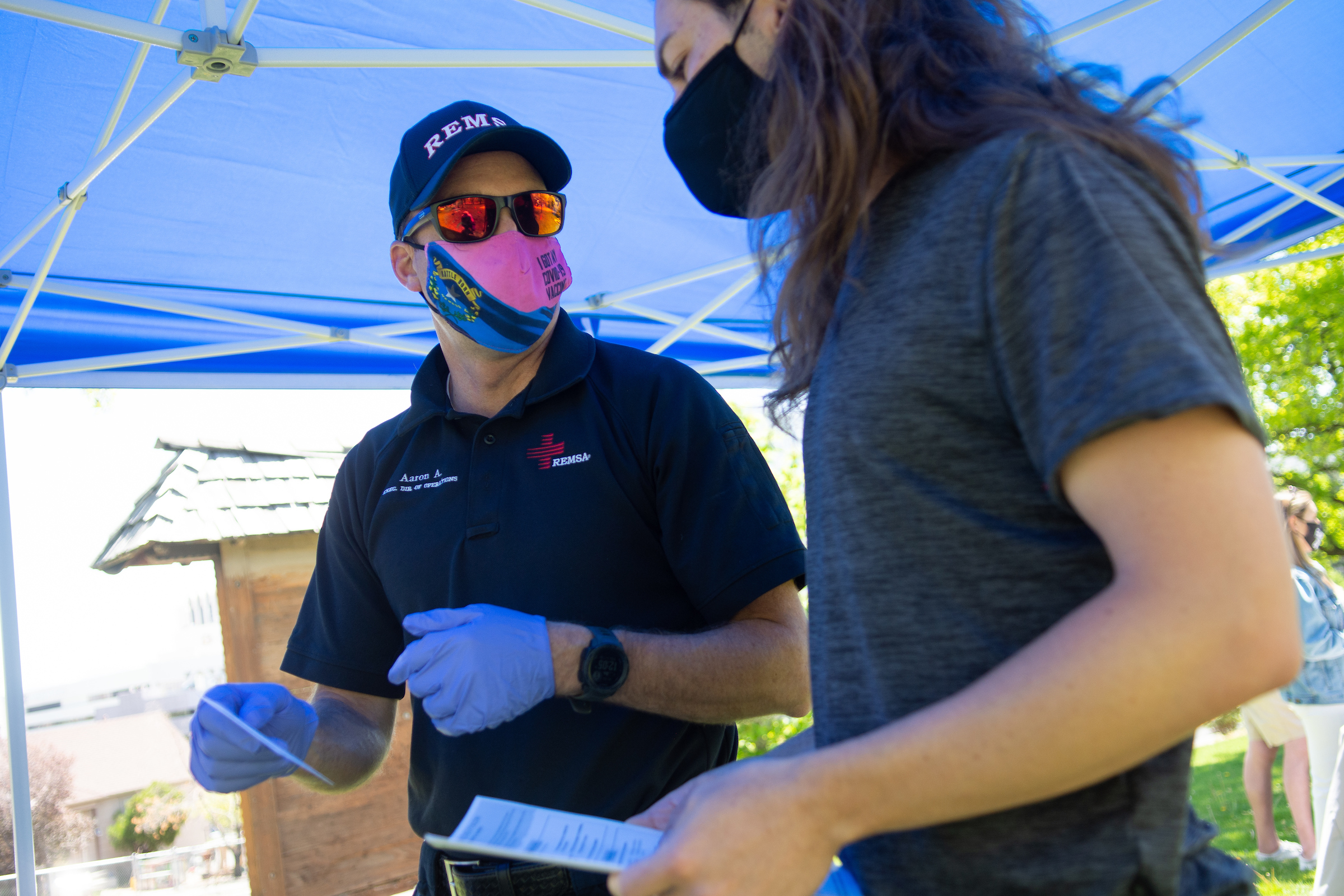Hello COVID my old friend

Having driven through Delta a time or two, I supposed it’s only fitting the latest COVID variant is so… Sevier.
Niche puns about western Utah geography aside (if you think the Loneliest Road is lonely in Nevada, keep driving east), there isn’t much humor to be found in the news surrounding the Delta variant of COVID-19. Of course, that’s fitting, too. There isn’t much humor to be found in Delta, Utah, former home of one of the United States’ 10 Japanese internment camps, either — though I did drive past one of the bizarre William Harrison billboards once. That was funny.
If you’re wondering why I would rather talk about a farm town on the eastern edge of the Great Basin instead of the latest phase of the pandemic — no, you’re not wondering. Which would you rather talk about? Which would you rather read about? Do you want to read yet another column about COVID-19 or would you rather read absolutely anything else? How many more times do you need to read these columns? How many more times do we need to write them? How many family members will go to the hospital this month? How many bodies are we going to bury?
Of course I’d rather write about a random town in Utah. You'd rather read it, too.
Speaking of Japanese internment camps, one of the cruel facts about World War II is that the final year of the war was every bit as deadly as the rest even though the outcome was a foregone conclusion. The atomic bombings of Hiroshima and Nagasaki certainly provided bloody punctuation points at the end, as one might expect when you vaporize two roughly modern-day Reno-sized cities in twin flashes of light, fire, wind, and radiation, but the body count was already well north of stratospheric long before V-J Day. The Battle of Berlin killed more soldiers and civilians than the two atomic bombs put together did. The death marches at the end of the Holocaust, as the Nazis evacuated their concentration camps by foot, would kill more people than the Battle of Berlin. Then there was the Pacific Theater, where Japan’s stubborn resistance — and the efforts the United States, China, and the rest of our allies took to break down that resistance — led to the deaths of millions and the near-total destruction of countless cities.
For the United States in particular, the last 12 months of the war were the bloodiest. The Battle of the Bulge, a last-ditch offensive by Nazi Germany in the woods of Belgium and France, killed more American soldiers than any other battle in the war. The Battle of Peleliu, which was supposed to finish in four days, instead took over two months and thousands of lives. The Philippines campaign, originally begun in mid-1944, was still ongoing by the time Japan surrendered — over 50,000 Americans had already been killed and wounded, and Japanese holdouts would continue fighting for years after the war ended. The Battle of Iwo Jima, famous because of Joe Rosenthal’s iconic photo depicting six Marines raising the American flag on Mount Suribachi, was the only battle in which American Marines suffered greater casualties than their Japanese opponents — it concluded less than six months before the dropping of the atomic bombs. Meanwhile, over 75,000 Americans were killed or wounded in the Battle of Okinawa — a little over a month later, Little Boy fell on Hiroshima.
Eighty years removed from World War II (the 80th anniversary of the bombing of Pearl Harbor is this December), it’s easy to pretend Americans, civilians and soldiers alike, all took the direction of the war as obvious and the sacrifices of the war as a given. It’s easy to pretend Americans read casualty reports about thousands of Americans dying overseas on seemingly random coral reefs, volcanic rocks, and various jungles months after Germany surrendered as the cost of doing business, as the necessary wages paid to defeat the evil forces who bombed Pearl Harbor. Doing so, however, would be an ahistorical mistake — would you want to die for a foregone conclusion? How would you react if your son lost a limb in a battle which had no possible bearing on the final outcome of the war? It’s not like Japan could possibly win in Iwo Jima, Okinawa, Peleliu, the Philippines, or anywhere else — and even if they did, so what? What difference would that make? Japan was out of oil, planes, ships, and time and everybody knew it — yes, even the Japanese. Would you expect Americans in 1945 to feel any different than you’d feel if you were put in their position?
Once again, the United States is faced with the tail end of a serious, lethal threat. Once again, many in our country would like to declare victory, raise a “Mission Accomplished” banner, and go back to normal. This is understandable. Normal is where most of us — not all of us, but more than enough of us — want to return to. We're tired of worrying, we're tired of fighting, we're tired of masking and distancing. We want our lives back.
Trouble is, COVID-19 isn’t ready to surrender just yet.
A big part of the problem is we have a reservoir of potential victims who we stubbornly refuse to vaccinate: Children, who are increasingly becoming a vector for infection. There is, however, a simple enough solution to this: Acknowledge that getting injected with a vaccine, even if you’re magically under the current 12-year-old threshold, was always less risky than catching a more child-friendly COVID-19 variant, then allow parents to voluntarily inoculate their young children against COVID-19 like we do for everything else.
Would every parent take their pediatrician up on giving their child a COVID-19 vaccine if given the opportunity? Absolutely not — just over 30 percent of children between the ages of 12 and 15 have received a single dose of a COVID-19 vaccine. But that number is still greater than zero and every former disease vector helps.
Another helpful direction Nevada should consider would be to follow Tennessee’s example — only in reverse. Tennessee, continuing in their longstanding tradition of being a state where one human being can legally own another, decided only adults should have convenient, voluntary access to vaccines and information about vaccines. After all, in Tennessee, children are the property of their parents and do not have actual freedoms or interests of their own.
Nevada, by contrast, should lead the way in the opposite direction. Any children who want to receive a vaccine in the State of Nevada should be able to walk into any clinic in the state and receive one, no questions asked.
Before any parents scream about how I’m suggesting we push needles into our children without parental consent — first of all, a child who volunteers to get vaccinated is a rare child indeed, and if a seven-year-old walks into a pharmacy on their own and asks for a vaccine, there’s probably a really good reason behind that, so shoot first and ask questions later. Secondly, did you attend a public high school? If we can convince teenagers it’s an act of edgy rebellion to get vaccines behind our backs, maybe we can also somehow convince them it would totally cheese us off if they left our liquor stash alone, finished their homework on time, and kept their room clean, too.
Besides, most of Nevada’s commercial-grade Thelemic traditions (“Do what thou wilt shall be the whole of the law, provided what thou wilt is regulated by the Gaming Commission”) are strictly adult-focused. Wouldn’t it be nice if we made some room for personal freedom for kids, too? Personally, I would rather give Nevada’s parents a chance to vaccinate our children, or even give Nevada’s children a chance to vaccinate themselves behind their parents’ backs, than follow California’s example of keeping mask mandates for another school year.
These suggestions do not require force — they simply require regulators and authorities to get out of the way and let people do what they want to do. Both of them would increase the number of Nevadans with vaccines, which would decrease the infectiousness and severity of COVID-19 within our state. Best of all, neither suggestion requires us to pay attention to a bunch of faux-contrarian political grifters who would root for Imperial Japan in World War II if doing so raised attention and money.
Directly confronting our fifth column in our fight against COVID is exactly what they want, just as the Imperial Japanese wanted us to throw American lives at well-fortified positions with little strategic purpose. They want to waste our time and our lives — the attention they steal from our time is how they win. Just as we didn’t need to fight over every scrap of island in the Pacific nearly 80 years ago, we don’t need to argue with every oppositionally defiant social media account today. Instead, let’s free everyone we can to make good health choices, then watch the fools and opportunists wither on the vine in obscurity.
It’s better than they deserve.
David Colborne was active in the Libertarian Party for two decades. During that time, he blogged intermittently on his personal blog, ran for office twice as a Libertarian candidate, and served on the Executive Committee for his state and county Libertarian Party chapters. He is now an IT manager, a registered non-partisan voter, and the father of two sons. You can follow him on Twitter @DavidColborne or email him at [email protected].
